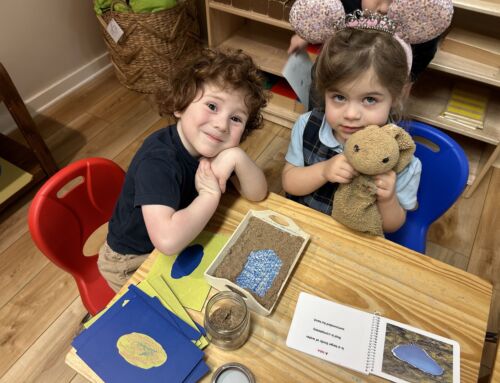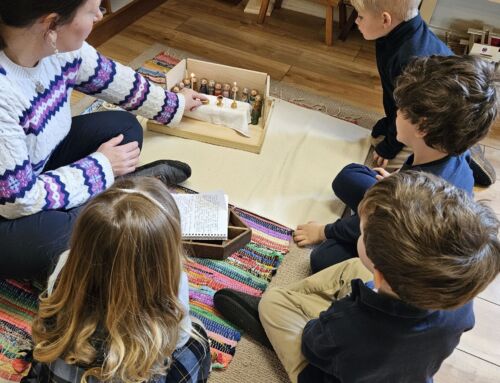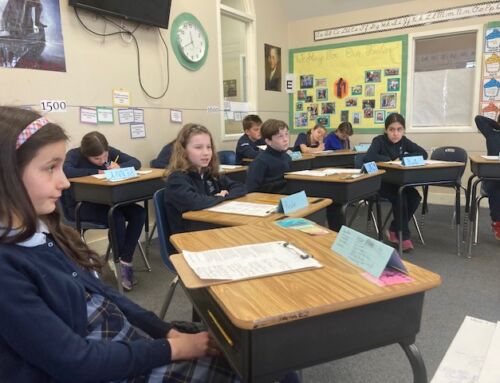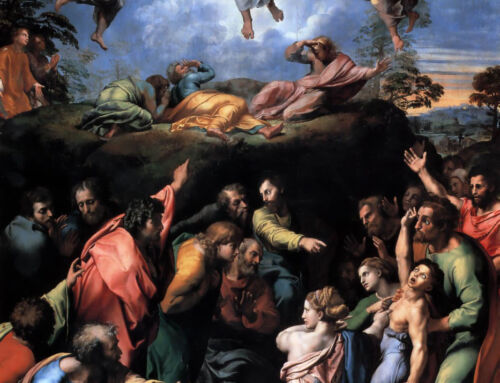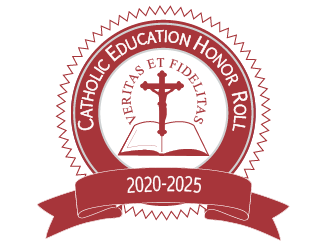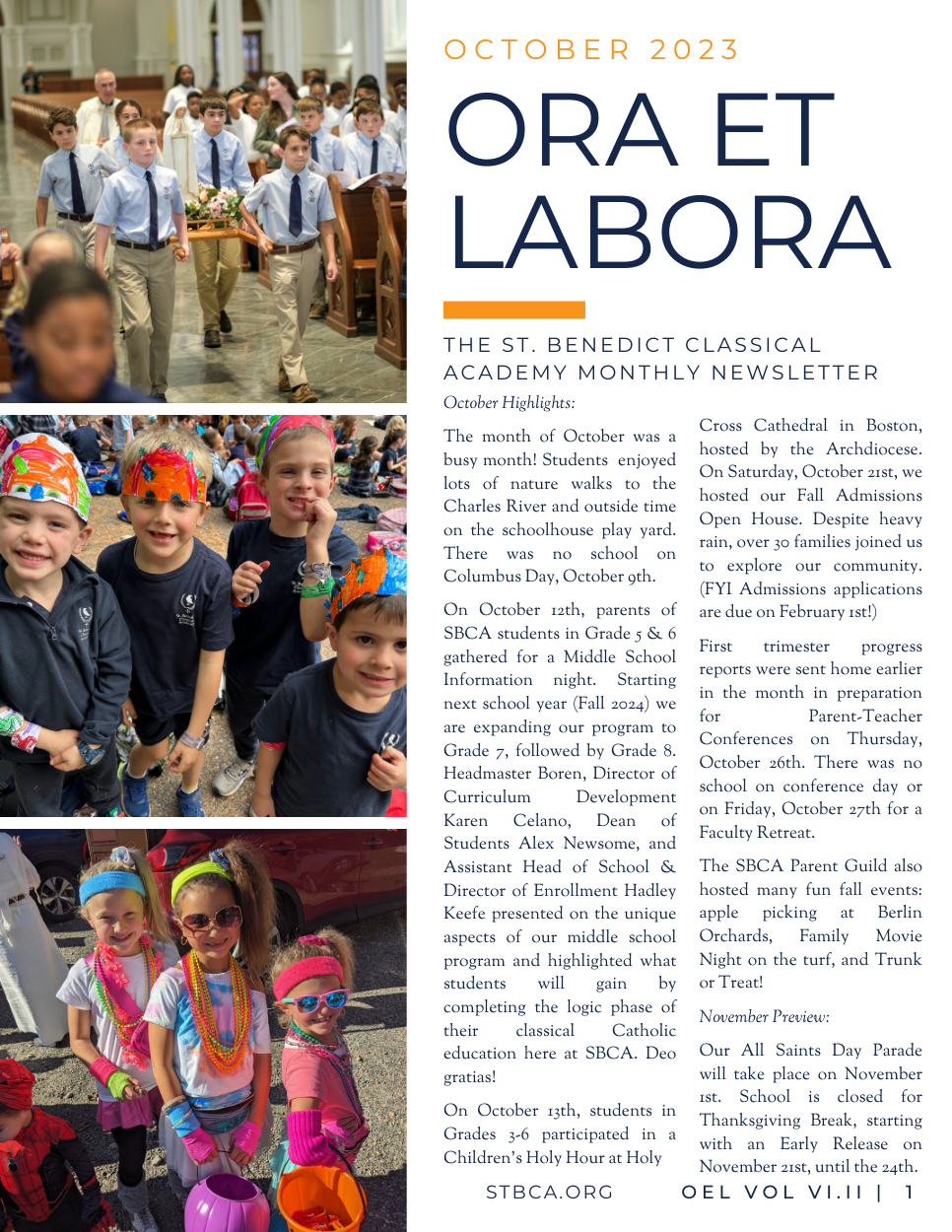“An education capable of saving humanity is no small undertaking; it involves the spiritual development of man, the enhancement of his value as an individual, and the preparation of young people to understand the times in which they live.”
Maria Montessori, Education and Peace – Speech in Copenhagen, May 1937
With man, the life of the body depends on the life of the spirit.
Maria Montessori, The Advanced Montessori Method I, p. 20
Our Montessori Pre-Kindergarten program at St. Benedict Classical Academy uses the Catechesis of the Good Shepherd (CGS) Program for our students’ faith formation—a Montessori-based religious education curriculum for children, with level options spanning ages three to twelve. Within our Level I CGS (ages 3 – 6), we create an “atrium”—a dedicated, sacred “hands-on” space in which the children witness the teachings of Jesus by hearing, pondering, and celebrating the most essential mysteries of scripture and liturgy.
By rights, to understand the teaching logic of CGS, one must appreciate the teaching design of Dr. Maria Montessori—an approach that addresses the whole child’s moral, intellectual, behavioral, emotional, and spiritual development. Dr. Montessori was an Italian medical doctor, child psychiatrist, anthropologist, and pedagogical expert. She also happened to be the second woman doctor in Italy, first Italian woman psychiatrist, an advocate for the rights of women and children, and a three-time nominee for the Pulitzer Peace Prize. Dr. Montessori spent countless hours (over fifty years) observing children, developing teaching apparatus, and designing the best educational approaches for children based on their age groups and unique learning styles. Her empirical studies and data, while time tested and true for over 100 years, have been more recently, reaffirmed through the latest technology devoted to neurology and learning—specifically studies on brain and language development.
Dr. Montessori believed that God’s wisdom is revealed in the child’s developmental stages. Each child follows a unique, natural, developmental plan that allows him/her to grow and develop physically, intellectually, morally, and spiritually. The aim of Dr. Montessori’s “method” of educating is to create for children conditions that best suit them developmentally and allow them to flourish. Carefully designed environments with furniture and materials proportionately sized to the children, enable them to succeed in functional independence with specific activities. These activities are designed to match the children’s interests and essential needs, with deep consideration of the children’s sensitive periods (i.e., temporary windows of time during which children are naturally, energetically empowered to learn developmentally required tasks). As children practice increasingly more challenging multi-step activities, their motor control and cognitions mature; the concentration and control involved support the development of their will and regulation thereof.
All obstacles and non-essential limitations, including any unnecessary adult interference, are removed to allow the child to follow his or her God-given developmental path to learning.
The child is the spiritual builder of mankind, and obstacles to his free development are the stones in the wall by which the soul of man has become imprisoned.
Maria Montessori, The Absorbent Mind, p. 221
Dr. Montessori believed that manipulating objects builds pathways of cognition as the mind remembers the feel and movements associated with materials. During free choice “work cycles”, materials, once presented, can be freely accessed by the children for independent practice and exploration. In a Montessori setting, the fundamental task for a young child is to develop their intellect and freedom. Teachers, referred to as Guides, give only enough information to present the most salient and, typically, singular concept to a child—leaving the most important discoveries for the child to make her/himself. Concepts graduate sequentially along the child’s personal progressions, from concrete to abstract.
To stimulate life, leaving it free, however, to unfold itself–that is the first duty of the educator.
Maria Montessori, The Discovery of the Child, p. 141
These essential principals are implemented by the adult guide in both the academic Montessori and CGS curricula.
Dr. Montessori first developed an atrium for children in 1910 at the request of Pope Pius X. This was the year Pope Pius X decreed children beginning aged seven could receive First Holy Communion, thus he requested Dr. Montessori create a pedagogy to aid children’s understanding of this holy sacrament. As a historical aside, Dr. Montessori enjoyed private audiences with numerous popes, including Benedict XV, who installed all her publications for the Vatican Library, and Popes Pius XII, John XXIII, and Paul VI. Blessed John XXIII, who observed Dr. Montessori teaching, was quoted as saying, “With her tender love for the child and her wisdom, she knows how to discover the child’s skills and lift them towards the light”. – Pope John XXIII, The Vita Dell’ Infanzia
Later, Montessori programs in Barcelona requested Dr. Montessori help them include Catholic teachings with their Montessori curriculum, and thus, she adjusted their environments to contain altar and sacristy models—the earliest templates to the eventual CGS materials. In 1954, Dr. Montessori’s initial religious curriculum was developed into a full faith formation program in Rome, Italy, between Gianna Gobbi, a Montessori teacher who trained directly under Maria Montessori, and Dr. Sofia Cavalletti, a biblical scholar. A long collaboration between Gobbi and Cavalletti resulted in the Catechesis of the Good Shepherd (CGS), which is used in Catholic and various, other Christian traditions, across 65 countries.
In CGS the children follow the Liturgical Season, beginning their relationship with Christ through physical means coupled with their own, precious contemplations, reflections, and discernment of the narratives, parables, gestures, and prayers that make up their Catholic faith. We invite the children to learn about and participate in the liturgical life of the Church by learning the liturgical calendar, altar articles and gestures throughout the year—the sharing of bread and “mingling” of the water and wine gaining greater prominence the nearer we get to the Last Supper. In the beginning of the year, biblical geography allows children to learn the names of Israel and the landmark towns, cities, and waterways detailing the events Holy Family’s lives and the ministry of Jesus. The children trace the steps of Jesus’ family beginning with where Mary received her historical visit from Angel Gabriel and culminating with the Magi visiting toddler Jesus. As the children develop familiarity with Israel, we dovetail the Infancy Narratives with prophecies of the Light, Mother, and so on. Themes of light and darkness, first explored during the prophecies, deepen with birth, death, and re-birth during Baptism lessons in the spring.
In CGS presentations, we keep it simple, reading and lifting up The Word with candlelight. The scripture presentations are often accompanied by a simple backdrop with handmade props—three dimensional figures for Infant and Paschal Narratives (denoting real life people) and flat for parables—the latter to subtlety indicate that these were stories told by Jesus. We conclude each scripture reading by inviting the children to wonder about the story and to offer up any thoughts and prayers of their own. We, the adults, hold the doctrinal content in our minds and hearts, but we do not reveal the answers. For example, in the Mystery of Life and Death lesson, the Doctrinal Content involves the theological fact that Jesus died, like the wheat seed, and rose again to give us eternal life. We meditate on Jesus as the seed and we are the fruit. Further, we hold the truth that there is a power continually at work within us, an inner dynamism that constantly urges us to become greater in our faithful actions. However, we don’t tell the children these truths! Our goal is to provide the introduction and allow the children to discover and arrive at their own “aha” moments. Whenever a child gains an internal understanding for any concept, the knowledge becomes a critical part of their development and creates self-assuredness. In the case of the Mystery of Life and Death lesson, the children’s work involves pondering the differences in the life stages of the seed and plant, so they take an indirect route to developing awareness of the more direct aim…how the life cycle of the seed relates to Jesus dying and rising again, and how growth from the seed relates to us.
So, what are we doing now in class? We are concluding our Parable studies and are poised to begin our Paschal Narratives beginning with The Last Supper. While the Lenten season offers adults and older children time to examine where our own darkness prevents us from participating in the life of Jesus, Lent is the perfect time for the youngest children to reflect on His Parables. As we enter the new Ordinary Time, marking the Season After Epiphany, the children learn or renew (in subsequent years) the Parable of the Good Shepherd—the story was so beloved to children, the creators of CGS took this title as their namesake. The 3 – 6 age group are inspired by the rapt attention and care the shepherd give his sheep, and the initial and subsequent Good Shepherd scenarios (i.e., Found Sheep), offer the first layer of moral, spiritual development. We invite the child’s further reflection of shepherd and sheep themes, as we sprinkle in Psalm 23, learning each line over the course of many weeks. As Lent begins, we explore the Kingdom of Heaven Parables—wondering over the remarkable power of the Mustard Seed and the successive parables of growth and treasure—those sought and those which come as gifts. We have just completed our Parables with “The Leaven” and the children were captivated by the aliveness of the yeast, which we mixed into flour and water. They observed that the leavened dough was “higher” with “bubbles” and “holes” in contrast to the flour without yeast, which was “flat” and “lower”. One five year-old boy said, “The yeast has power like God’s power in Heaven” and another child said the yeast, “has love like God’s love”.
As we grow closer to the Paschal season, the children grow closer to Jesus and can very freely be heard offering their nuggets of understanding and wisdom. It has been my observation, that the Primary children—living on their unique plane of development— are not only attuned at every physical level but seem to have an open access to the spiritual realm that is simultaneously both matter of fact and profound. As Sophia Cavalletti so aptly said (The Religious Potential of the Child), “All that we have been able to observe over these years…leads us to consider the child as a ‘metaphysical’ being—who moves with ease in the world of the transcendent and who delights in— satisfied and serene—the contact with God.”
My greatest joy, as a guide and catechist, is to bear witness to the quiet moments when children express their understanding and connection to all learning—especially when revealing their connection to the Holy Spirit. Below, I end this essay with an excerpt from Dr. Montessori, in her prologue to her book, The Mass Explained to Children. She compares the importance of respecting the child’s development while teaching Catechism and, in doing so, she uses our Lord’s quotes regarding “Suffer the little children to come unto Me” (Matthew 19:14, Mark 10:14 and Luke 18:16) and “I say unto you, unless you be converted, and become as little children, you shall not enter into the Kingdom of Heaven. Whosoever therefore shall humble himself as this little child, the same is greatest in the kingdom of Heaven.”
“Our Lord perceived in children something that the adult did not perceive two thousand years ago and does not perceive today. Yet the Gospel says plainly that many mysteries shall be revealed to these little ones. Christ’s teaching about children touches the very core of their education; they have a different personality from ours, and spiritual impulses are alive in them, which may be atrophied in the grown man. We must always keep this fact in mind so that we may be prepared not only to offer children the noblest teaching, but to offer it in a worthy form. We are bound to help children by teaching them what they need to know about religion, but we should not forget that the child could help us, too, by showing us the way to the Kingdom of Heaven. A great respect for the individuality of the child should be part of our deepest Christian thought; and putting this thought into practice should tend to the personal refinement of every religious teacher.“
Maria Montessori, The Mass Explained to Children, pp. vii – viii
AUTHOR: Kellie Young, Pre-Kindergarten Lead Teacher

